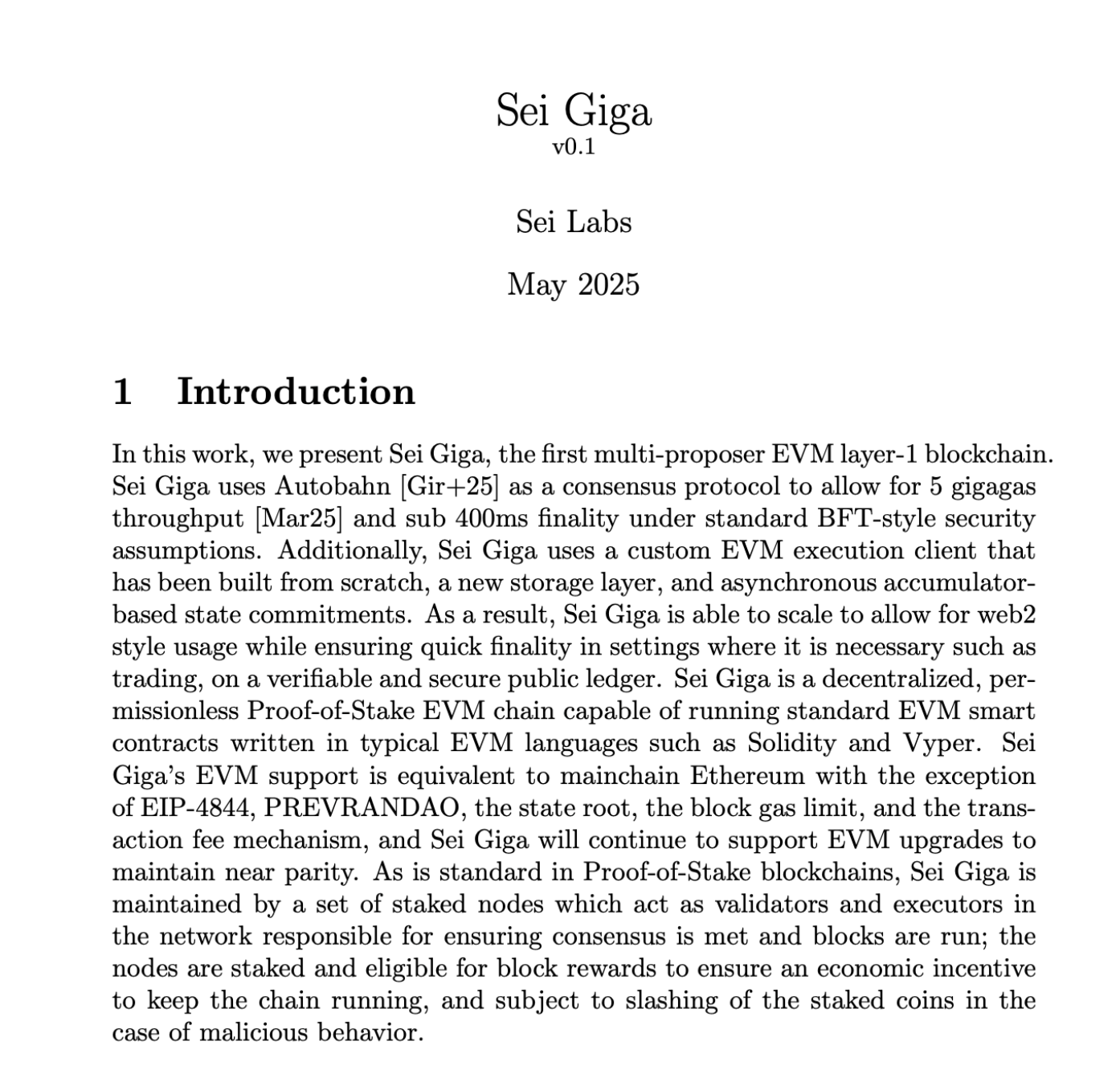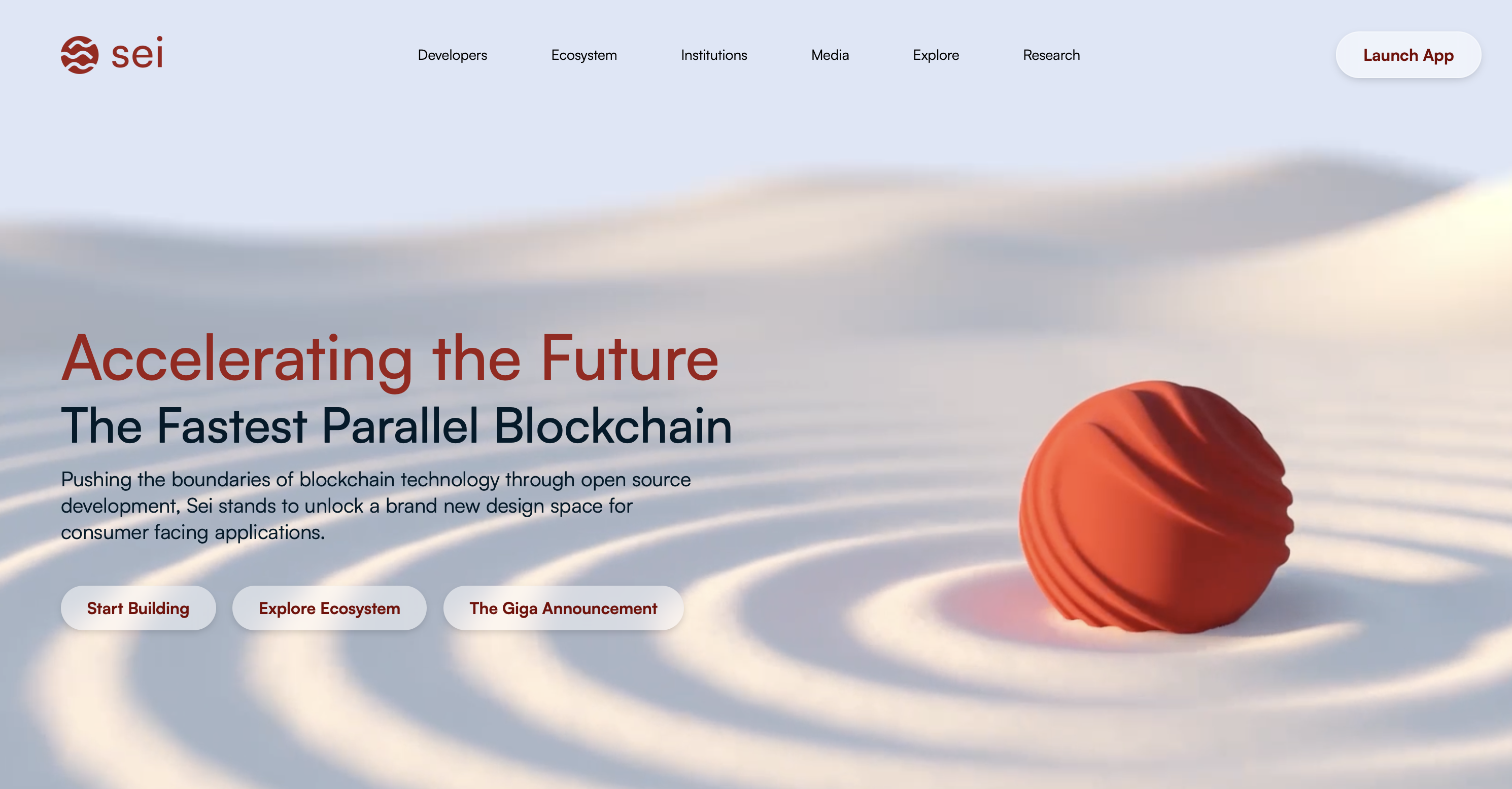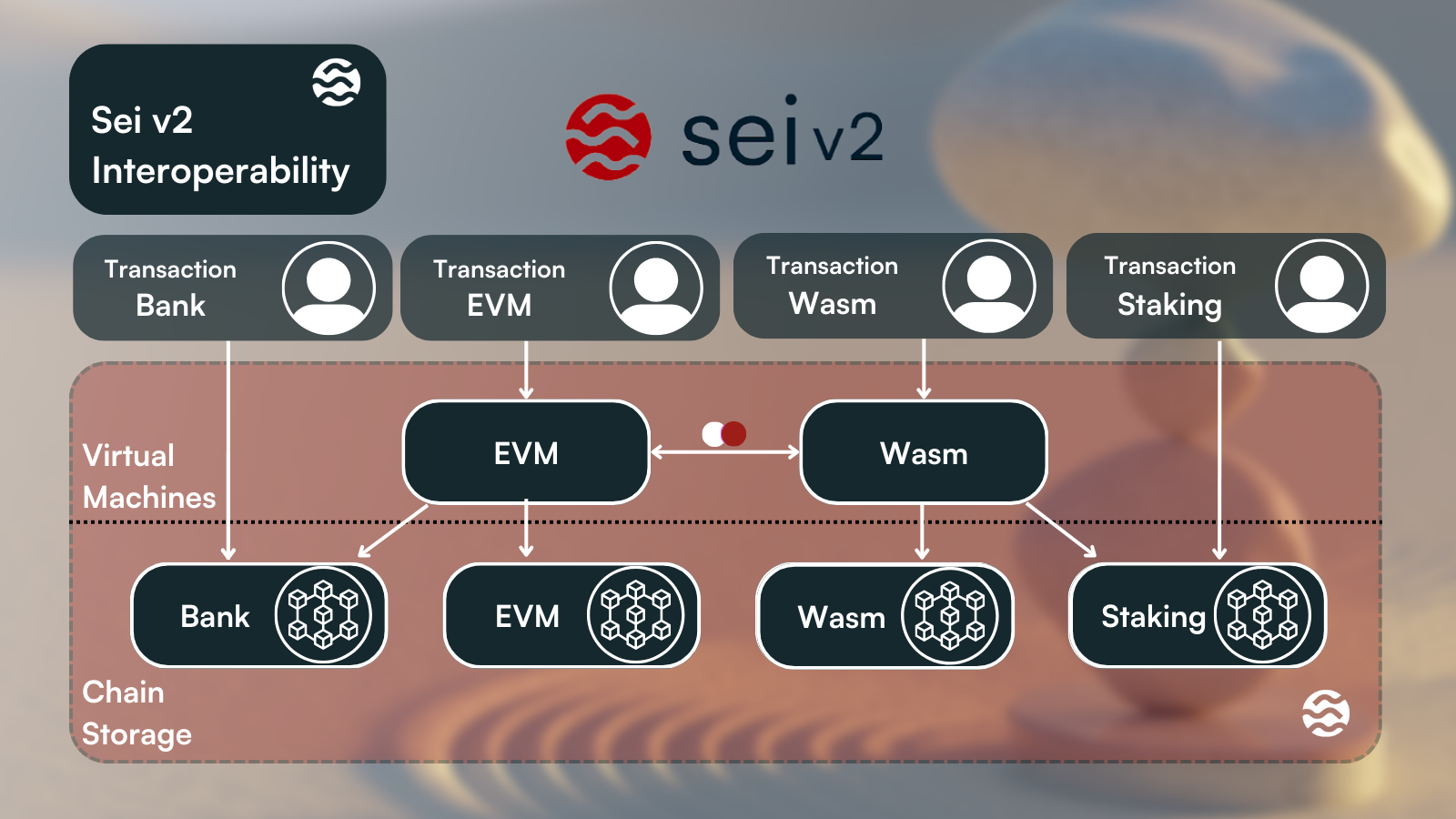
Key Takeaways
- Sei is a layer-1 blockchain featuring a parallelized Ethereum Virtual Machine (EVM) that processes multiple transactions simultaneously, achieving 400ms finality and up to 12,500 transactions per second.
- The Twin Turbo Consensus and Optimistic Parallelization technologies enable Sei to deliver performance improvements suitable for high-frequency trading and real-time applications.
- Sei combines Ethereum’s developer-friendly environment with advanced parallelization techniques similar to Solana, creating a unique hybrid architecture.
- The upcoming Sei V2 upgrade enhances EVM compatibility, optimizes parallelization, and introduces SeiDB for improved state management.
- Sei’s ecosystem is growing with applications focused on DeFi, gaming, and NFT marketplaces that benefit from its high-speed, low-latency infrastructure.
Sei (SEI) stands at the forefront of blockchain innovation as the self-proclaimed “fastest parallel blockchain” in the industry. This Layer-1 blockchain platform combines the developer-friendly environment of Ethereum with advanced parallelization techniques that allow it to process multiple transactions simultaneously. Since its mainnet launch in August 2023, Sei has been gaining momentum with its promise of ultra-fast finality and high throughput, making it particularly suitable for applications that require real-time responses, such as decentralized finance (DeFi) and gaming.
The recent development of Sei V2, which introduces a parallelized Ethereum Virtual Machine (EVM), has further positioned it as a potential game-changer in the blockchain space. As of April 13, 2025, Sei (SEI) is trading at $0.1470, with a circulating supply of 4.88 billion tokens and a market capitalization of approximately $739.27 million, placing it at #53 in the overall cryptocurrency rankings.
Sei has released its newest whitepaper in May 2025, Sei Giga.

What Is Sei?
Sei is a blockchain infrastructure platform that delivers a parallelized Ethereum Virtual Machine (EVM) execution layer. It aims to address the scalability and performance limitations that have hindered widespread blockchain adoption. By leveraging attributes from both Solana and Ethereum, Sei creates a hybrid architecture that combines the best of both worlds: Ethereum’s developer-friendly environment and Solana’s high-performance capabilities.

First announced in May 2022, Sei was created with the ethos of “prioritizing reliability, security, and high throughput above all else.” After a series of testnets, including the Seinami Incentivized Testnet (Atlantic-1) in July 2022 and an upgraded Atlantic-2 testnet in March 2023, Sei launched its “public beta” Pacific-1 mainnet on August 16, 2023. Since then, it has been working toward the release of Sei V2, which promises significant enhancements to the network’s performance and usability.
Who Is Behind Sei?
Sei was founded by a trio of blockchain entrepreneurs and technologists: Dan Edlebeck, Jayendra Jog, and Jeff Feng. Jayendra Jog serves as the Co-founder of Sei Labs, bringing his technical expertise to the development of the platform. The team’s vision has attracted support from numerous elite global institutions and venture capital firms, positioning Sei at the forefront of blockchain innovation.
The project has garnered backing from notable investors, including Circle Ventures, Multicoin Capital, Coinbase Ventures, and Delphi Digital. Wyatt Lonergan, Principal at Circle Ventures, highlighted that “The Sei ecosystem aligns with our commitment to working with founders and teams dedicated to open access and programmable commerce.” Similarly, Spencer Applebaum, Investment Partner at Multicoin, expressed amazement at Sei’s “pace of execution,” further validating the team’s capabilities and vision.
How Sei Works: A Technical Explanation
Sei’s architectural innovation centers around four key technological advancements that collectively deliver unprecedented blockchain performance. At its core, Sei implements a Twin Turbo Consensus mechanism that enables it to achieve block finality in just 380-400 milliseconds, making it one of the fastest blockchains in the industry. This rapid finality is crucial for applications requiring real-time responses, such as high-frequency trading platforms and interactive games.
The second pillar of Sei’s technology is Optimistic Parallelization, which revolutionizes transaction processing. Unlike traditional blockchains that process transactions sequentially, Sei’s parallelization engine, similar to Solana’s Sealevel, allows multiple independent transactions to be executed simultaneously across all available CPU cores. This parallel processing capability significantly increases throughput without compromising security or decentralization. In Sei V2, the platform takes this further by assuming all transactions can be processed in parallel by default, only reverting to sequential processing when dependencies are detected, which simplifies development.
SeiDB represents another major innovation, fundamentally changing how state access, commitment, and storage functions within the blockchain. By decoupling state commitment from state store and replacing GoLevelDB with PebbleDB, Sei achieves faster read/write performance during multi-threaded access. This optimization reduces state bloat, enhances node synchronization, and improves overall system efficiency, particularly when handling the high transaction volumes that parallel processing enables.
Finally, Sei’s Interoperable EVM allows for seamless communication between different components of the ecosystem. Transactions across various elements (Cosmwasm, EVM, bank, staking) can interact coherently, creating a unified developer experience. This interoperability extends to the broader blockchain ecosystem, with Sei supporting integration with the Inter-Blockchain Communication (IBC) protocol used in the Cosmos ecosystem, enabling assets and data to flow between different blockchains.

Current Status of Sei In The Wider Ecosystem
Sei has established itself as a notable player in the high-performance blockchain sector, competing in a space dominated by platforms like Solana. With its focus on speed and efficiency, Sei is particularly well-positioned for applications that require instant finality and rapid transactions at scale. The ecosystem currently boasts over $410 million in Total Value Locked (TVL) and has attracted approximately 16 million wallets, indicating growing adoption despite its relatively recent launch.
Within the blockchain landscape, Sei occupies a unique position by bridging the gap between Ethereum’s developer ecosystem and the high-performance capabilities traditionally associated with Solana. This hybrid approach allows it to attract developers from both ecosystems, potentially accelerating its adoption. However, the platform currently faces challenges in terms of developer adoption and dApp diversity, with one protocol (AstroPort) accounting for over 90% of its total TVL, according to community observations.
The gaming sector represents a significant opportunity for Sei, as its high throughput and near-instant finality create an ideal environment for blockchain games that require numerous rapid transactions. Similarly, NFT marketplaces benefit from Sei’s nominal transaction fees and scalability, making it accessible to creators and collectors. In the DeFi space, Sei’s fast execution enables more sophisticated trading strategies and improved user experiences, although the ecosystem still lacks some key components like robust lending markets.
Sei’s Price Journey
Sei’s price history has been marked by significant volatility typical of emerging blockchain platforms. Since its launch, SEI has experienced both impressive rallies and substantial corrections. The token reached an all-time high of $1.14, representing a substantial increase from its all-time low of $0.0079. This price action demonstrates both the potential that investors see in the technology and the speculative nature of the cryptocurrency market.
As of April 13, 2025, SEI is trading at $0.1470, which represents a significant drop from its all-time high (down approximately 87.11%) but still a substantial increase from its all-time low (up approximately 1,742.52%). Recent price movements show a mixed short-term trend, with a 2.08% increase over the past 24 hours but a 7.88% decrease over the past week. These fluctuations reflect the broader market conditions and investor sentiment toward layer-1 blockchain platforms.
Current Data & Interesting Statistics About Sei

- Sei achieves an industry-leading 400 millisecond time to finality, making it one of the fastest blockchains for transaction confirmation.
- The platform supports up to 12,500 transactions per second theoretically, with current performance at approximately 5,030 TPS.
- Over 16 million wallets are currently active in the Sei ecosystem, indicating growing adoption despite its relatively recent launch.
- Sei’s total value locked (TVL) exceeds $410 million, demonstrating substantial capital commitment to the platform.
- The market capitalization of SEI stands at approximately $739.27 million as of April 13, 2025, ranking it #53 among all cryptocurrencies.
- The circulating supply of SEI is 4.88 billion tokens, with trading volumes averaging around $1.5 million daily.
- Sei’s ecosystem currently supports various application categories, including DeFi, gaming, and NFT marketplaces, with over 90% of TVL concentrated in a single protocol.
What Is The Future of Sei?
Sei’s roadmap focuses on the full implementation of Sei V2, scheduled for deployment to mainnet in the first half of 2024. This major upgrade promises to enhance the platform’s scalability and performance through the introduction of EVM compatibility, optimistic parallelization, and SeiDB. Additional planned developments include MEV Auctions, Intra-validator Sharding, and ZK Light Clients, all aimed at further improving the network’s efficiency and capabilities.
The success of Sei will largely depend on its ability to attract developers and users from both the Ethereum and Solana ecosystems, leveraging its unique position as a bridge between these communities. As the blockchain sector continues to mature, platforms that can offer both developer-friendly environments and high performance will likely gain the most traction. Sei’s focus on specific use cases like high-frequency trading and gaming could provide the differentiation it needs to carve out a significant market share. The ultimate test for Sei will be whether its technological advantages translate into meaningful real-world adoption beyond speculative trading.
A New Standard for Blockchain Performance
Sei represents a significant evolution in blockchain technology, combining the developer accessibility of Ethereum with the performance capabilities of next-generation platforms. Its unique approach to parallelization and consensus has enabled it to achieve impressive technical benchmarks, potentially setting a new standard for what users and developers can expect from blockchain infrastructure. While the platform still faces challenges in terms of ecosystem development and adoption, its technological foundation provides a solid base for future growth.
As the cryptocurrency industry continues to mature, platforms like Sei that prioritize both performance and usability will likely play an increasingly important role in bringing blockchain technology to mainstream applications. For investors, developers, and users alike, Sei offers an intriguing glimpse into what the future of decentralized applications might look like when freed from the performance constraints that have limited previous generations of blockchain platforms.






